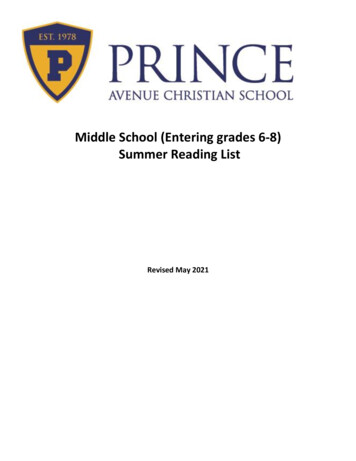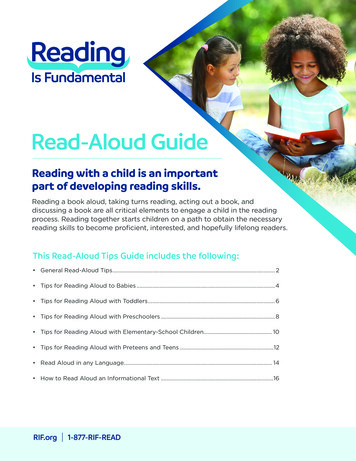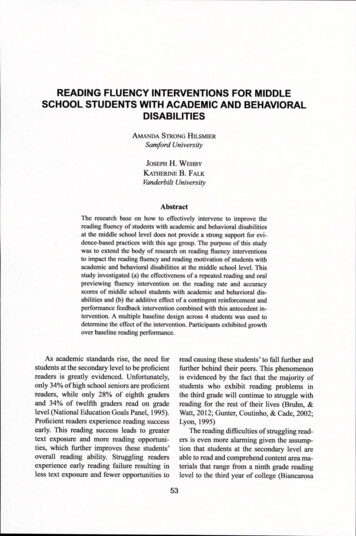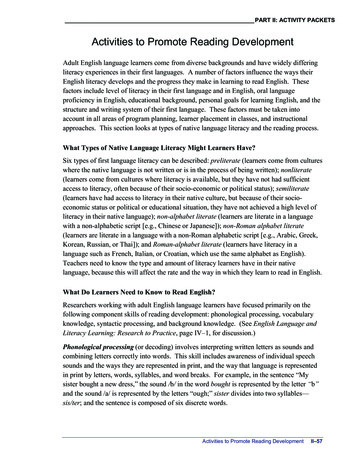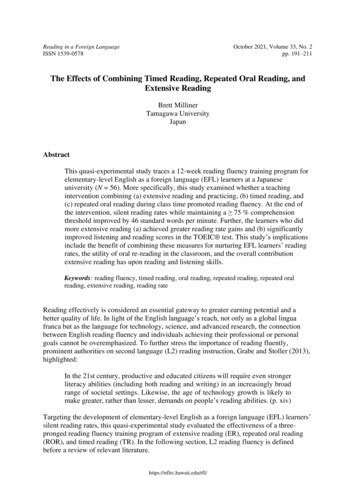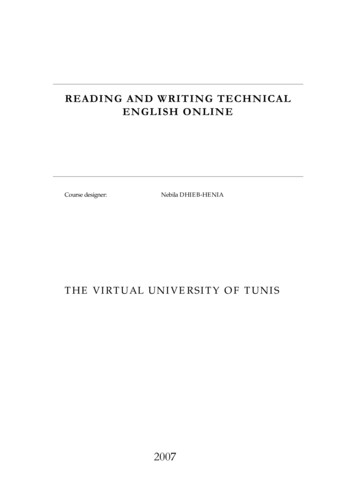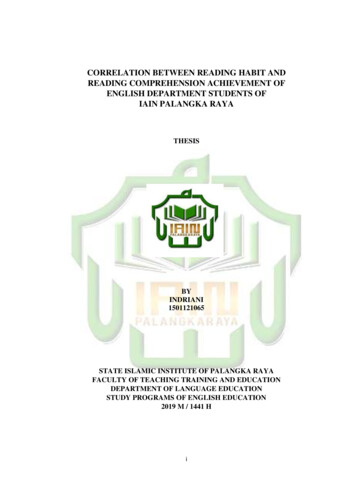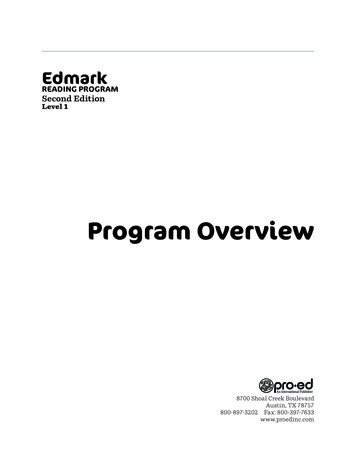
Transcription
EdmarkREADING PROGRAMSecond EditionLevel 1Program Overview8700 Shoal Creek BoulevardAustin, TX 78757800-897-3202 Fax: 800-397-7633www.proedinc.com
2011, 1992 by PRO-ED, Inc.8700 Shoal Creek BoulevardAustin, Texas 78757-6897800/897-3202 Fax 800/397-7633www.proedinc.comAll rights reserved. No part of the material protected by thiscopyright notice may be reproduced or used in any form or byany means, electronic or mechanical, including photocopying,recording, or by any information storage and retrieval system,without prior written permission of the copyright owner.ISBN 978-1-4164-0504-7IllustratorsScott R. Brooks—Phrase Match Boards, StoriesAudrey Durney—Picture Match CardsLalena Fisher—HomeworkJanet McDonnell—The RidesChris Vallo—ComprehensionPrinted in the United States of America1234567891020191817161514131211
ContentsAcknowledgments. . . . . . . . . . . . . . . . . . . . . . . . . . . . . . . . . . . . . . . . . 1Quick Tour . . . . . . . . . . . . . . . . . . . . . . . . . . . . . . . . . . . . . . . . . . . . . . 2Introduction . . . . . . . . . . . . . . . . . . . . . . . . . . . . . . . . . . . . . . . . . . . . . 4Research-Based Support for the Edmark Reading Program . . . . . . . . . 7Teaching Strategies . . . . . . . . . . . . . . . . . . . . . . . . . . . . . . . . . . . . . . 12Using the Edmark Reading Program . . . . . . . . . . . . . . . . . . . . . . . . . . 14Mastery Test . . . . . . . . . . . . . . . . . . . . . . . . . . . . . . . . . . . . . . . . . . . . .16Discrimination Test . . . . . . . . . . . . . . . . . . . . . . . . . . . . . . . . . . . . . . . . .17Prereading . . . . . . . . . . . . . . . . . . . . . . . . . . . . . . . . . . . . . . . . . . . . . . 18Word Recognition . . . . . . . . . . . . . . . . . . . . . . . . . . . . . . . . . . . . . . . . . 20Posttest . . . . . . . . . . . . . . . . . . . . . . . . . . . . . . . . . . . . . . . . . . . . . . . . 24Picture Match . . . . . . . . . . . . . . . . . . . . . . . . . . . . . . . . . . . . . . . . . . . . 26Phrase Match . . . . . . . . . . . . . . . . . . . . . . . . . . . . . . . . . . . . . . . . . . . . 30Stories . . . . . . . . . . . . . . . . . . . . . . . . . . . . . . . . . . . . . . . . . . . . . . . . . 33Comprehension . . . . . . . . . . . . . . . . . . . . . . . . . . . . . . . . . . . . . . . . . . . 35Spelling . . . . . . . . . . . . . . . . . . . . . . . . . . . . . . . . . . . . . . . . . . . . . . . . 37Take-Away Readers . . . . . . . . . . . . . . . . . . . . . . . . . . . . . . . . . . . . . . . . 39Homework . . . . . . . . . . . . . . . . . . . . . . . . . . . . . . . . . . . . . . . . . . . . . . .41Reading and Social Skills Games . . . . . . . . . . . . . . . . . . . . . . . . . . . . . . 43Bingo . . . . . . . . . . . . . . . . . . . . . . . . . . . . . . . . . . . . . . . . . . . . . . . . . . 45The Rides . . . . . . . . . . . . . . . . . . . . . . . . . . . . . . . . . . . . . . . . . . . . . . . .47Additional Classroom Activities . . . . . . . . . . . . . . . . . . . . . . . . . . . . . . . 48iii
References. . . . . . . . . . . . . . . . . . . . . . . . . . . . . . . . . . . . . . . . . . . . . . . . 52AppendixesA. Level 1 Words in Order by Lesson Number . . . . . . . . . . . . . . . . . . . . 54B. Level 1 Words in Alphabetical Order With Lesson Number . . . . . . . . . 55C. Objectives of the Edmark Reading Program—Levels 1 and 2,Second Edition. . . . . . . . . . . . . . . . . . . . . . . . . . . . . . . . . . . . . . . . . 56D. Edmark Reading Program—Level 1, Second EditionD. Materials Available Separately From PRO-ED, Inc. . . . . . . . . . . . . . . . . 58iv
AcknowledgmentsSincere appreciation is extended to the following people who have contributed to thecreation of the Edmark Reading Program, Second Edition.Development Team: Beth Donnelly, Chris Anne Worsham, Becky Shore, BethRowan, Cheri Richardson, and Kathy SynatschkProduction Team: Jason Crosier, Darinda Huntley, Jan Mullis, Sandy Salinas, MelissaTullos, and Alicia WoodsComponentsWord Signs DVD: Franky L. Ramont, Annie Marks, and David SimmonsComprehension: Patti AustinHomework: Kay Diehl OsbornArtists: Scott R. Brooks, Audrey Durney, Lalena Fisher, Janet McDonnell, NicoleTugeau, and Chris ValloWe also extend our appreciation to the numerous teachers, paraprofessionals, parents,and students whose feedback and suggestions about the Edmark Reading Program havebeen valuable in the improvement of the program.Special thanks to Carol Dyas, Nadine Gregory, Cecilia Harper, Mary AnneHermann, Kristy A. High, John D. Kidder, Liz Parker, Rene Rassoulian,Bonnie Royer, Linda Schardt, Betsy Sears, Stephen I. Sulzbacher, andMary Ann Trower for their contributions to the first edition of the EdmarkReading Program.1
Quick TourEdmarkREADING PROGRAMSecond EditionLevel 1EdmarkMastery TestDates of Testing throughType of Administration:Examiner’s NameLevel 1GroupEdmarkLevel 1IndividualDates of Testing throughType of Administration:Student’s NameAnswerStudent’s NameIdentification NumberCheck honepaperslowbikepicturegamestreetotherStudent’s 4172736515272738394111121126140152Reading Level123 eCheck 344753668189101105117124134153q throughSchool Gradew throughe throughReading 151193032495570808895103114123136151 Progress Graphs ProgramOverview WordRecognition Picture Match CardsonlyPhrase Match CardsonlyStories Reading andSocial SkillsGames Display Mask 8580127570116510WordGroupsMasteredReading Levels 959013 1001514 Lesson Plan/Record BookReading Level123 DATESubtest 2: Picture/Phrase MatchCheck ifCorrect Recommendations Total WordsCorrectTotal WordsCorrectDates of Test AdministrationsBirth Date AgeExaminer’s NameSubtest 3: Word RecognitionSubtest 1: GroupSubtest 1Subtest 2Examiner’s NameMastery TestSummarySummary FormFormScoringScoring FormFormSubtest 1Subtest 2Sold*Separately*MasteryMastery TestTestREADING PROGRAMSecond EditionMasteryMastery TestTestREADING PROGRAMSecond EditionStudent BookletCoreKitReading levels are provided for the words scored inthis test for informational purposes only. Althoughsome of the words are 2.0 or 3.0, Level 1 teaches 150basic sight words plus endings (-s, -ed, -ing) and takesa nonreader to approximately a 1.0 reading level.609%WordsCorrect876403525420315102 45305 51qTotal WordsCorrect5550wAdministration 2011, 2008 by PRO-ED, Inc.1 2 3 4 5 6 7 8 9 10 20 19 18 17 16 15 14 13 12 11eqweAdministration 2011, 2008 by PRO-ED, Inc.1 2 3 4 5 6 7 8 9 10 20 19 18 17 16 15 14 13 12 11EdmarkREADING PROGRAMSecond EditionLevel 1Lesson Plan/Record BookStudentTeacherSchool YearLesson 51a horse4a horse2a car5a horse3a car6a cara cara horse1 horsehorse1a box12
Certificate of Completionhas successfully completed theEdmarkREADING PROGRAMLevel 1TeacherDonald D. Hammill, Ed.D.PresidentPRO-ED, Inc.CoreKitSold*Separately*Word SignsDVD The Rides andCertificate ofCompletion DateComprehension Spelling Take-AwayReaders Homework Bingo Resources flashdrive includes: Comprehension Spelling Take-AwayReaders Homework Bingo 3*See Appendix D.
IntroductionThe Edmark Reading Program has long helped students who need an alternative to phonicslearn to read. The key to this success is the program’s use of a carefully sequenced, highlyrepetitive word recognition method combined with errorless learning. The program motivates students by breaking learning into steps that ensure that even the poorest readersachieve over 90% accuracy. This approach eliminates incorrect responses and helps students view themselves as readers. The Edmark Reading Program ensures success to students of all ages who have not yet mastered beginning reading.Students with a variety of differences and disabilities (e.g., students with developmentaldisability, intellectual disability, autism, hearing impairment, reading disability, or learning disability; learners of English as a second language) learn to read using the EdmarkReading Program. Edmark Reading Program serves as the sole reading program for manystudents or as a supplement to a phonics-based or other type of reading program. Studentsfrom preschool through adulthood are successful with the Edmark Reading Program.Across Levels 1 and 2, the Edmark Reading Program provides repeated encounterswith 350 frequently seen sight words and three word endings. Students begin by recognizing and reading a new word in isolation and then in the context of phrases, sentences, andstories. They use their newly learned words in a variety of reading activities, which includematching pictures to words, using manipulatives, reading story books, practicing spelling and writing, and playing interactive card and board games for reinforcement of wordrecognition and comprehension. This extensive practice reinforces new learning, ensuresautomatic word recognition, and facilitates the generalization of students’ reading skills tonew and varied situations. Playing games provides the opportunity for students to practicetheir reading skills in a social setting and requires quick recognition and reading of thetarget words. Errorless learning involves prompting students to recognize new words andparticipate in new activities without making errors. As a student experiences success, support is gradually reduced. When they require additional practice on a target word, studentscan spend additional time working on their favorite activities or repeat activities in whichthey made errors.In Level 1, students learn 150 frequently seen sight words from kindergarten andGrade 1 reading levels, and the endings -s, -ed, and -ing. In Level 2, students learn an additional 200 words from Grades 1–3 reading levels. The words in the two levels, whichinclude easy words, such as the and run, and more complicated words, such as different andvegetable, will be encountered throughout a reader’s lifetime.ObjectivesThe principal objectives for Level 1 and Level 2 of the Edmark Reading Program are listedbelow. A complete list of objectives can be found in Appendix C. The student will learn todo the following:4 Read and comprehend frequently seen vocabulary words Read and comprehend phrases and sentences Read and follow directions in phrases and sentences Read and comprehend stories
Read fluently Generalize skills to a variety of reading activities Spell words Read, comprehend, and generalize words while playing games and interactingwith peers Comprehend and use words in sign language (for students with difficulties withverbal expression)Level 1 WordsIn Appendix A, the words the students will learn in Edmark Reading Program—Level 1 arepresented in the order in which they are taught. Appendix B lists the words in alphabeticalorder.Student PrerequisitesStudent prerequisites are minimal. Students must be able to do the following:1.Point—The student must be able to point or respond in some way to indicate ananswer.2.Say or sign words—The student, upon teacher cue, must be able to say or sign thetarget word. The response need only be accurate enough for the teacher to determine that the student is responding correctly.3.Understand language—The student must have sufficient receptive language to follow the teacher’s cues.Changes to the Second EditionTeachers, parents, and students were asked for recommendations for changes to the secondedition of Edmark Reading Program. Suggestions included integrating the many components, providing a guide to lesson planning and progress monitoring, providing more stories for comprehension practice, and improving the appearance. In response to this feedback, the second edition of Edmark Reading Program offers new activities, an expandedcomprehension emphasis, and an updated look, while keeping the familiar methods andmaterials from the first edition. Long-time users will be happy to know we made onlyminor changes to the core activities. The second edition also includes all new illustrations.Various new materials have been added, including the Mastery Test, Reading and SocialSkills Games, and a simplified Lesson Plan/Record Book. A detailed list of the changesmade to the Edmark Reading Program follows.1.Organization—The words are taught in the same order as in the previous edition,but the numbering of the lessons and activities has been simplified. Lessons arenumbered in sequential order (1–153 for Level 1), each teaching a single word.2.Word Recognition—The lessons, bound in three spiral-bound books, have beenrenumbered with the new lesson numbers.3.Stories—The three books contain multiple stories. The books are illustrated withnew full-color art.5
64.Mastery Test—This test is now integrated into the program. Teachers administerthe Mastery Test to obtain baseline data, to help in developing IndividualizedEducation Programs (IEPs), and to monitor progress.5.New activities—The following materials, which were formerly supplemental, havebeen integrated into the program to provide students with more reading experiences: Comprehension (previously called Supplemental Worksheets), Homework,Spelling, Take-Away Readers (previously called Edmark Readers), and Bingo.6.Resources flash drive—Resource materials are available in electronic format. Includes: Comprehension, Homework, Spelling, Take-Away Readers, and Bingo.7.Lesson Plan/Record Book—This booklet combines lesson planning and documentation of student achievement in one convenient document.8.Reading and Social Skills Games—New games are used to reinforce students’learning and promote generalization of reading skills to a social setting.9.The Rides—This story, provided as a reward for completion of the program, usesall of the words taught in Level 1.10.Word Signs–Level 1 and Level 2, DVD—A video word-signing guide on DVD isincluded for use with students who have difficulties with verbal expression.11.New look—All illustrations in the program have been newly created to appeal toreaders of all ages.
Research-Based Supportfor the Edmark Reading ProgramFor many children who have never mastered beginning reading and language, a carefullysequenced, highly repetitive sight-word approach offers the highest probability of success.Edmark Reading Program offers such an approach.Edmark Reading Program was developed through careful research conducted in the1960s. Originally called the Rainer Reading Program, Edmark Reading Program becamecommercially available in 1972 and has proven effective with preschool students (ages 3–5years), elementary students having difficulty with traditional classroom reading materials, students learning English as a second language, and most special education students.Edmark Reading Program should be considered for use with any student who has notlearned to read.Reading ResearchEdmark Reading Program applies the principles of behavioral psychology to the educationof children with mild and moderate levels of intellectual disability (Bijou, 1965; Birnbrauer,Bijou, Wolf, & Kidder, 1965; Skinner, 1961). These principles relate to errorless discrimination (Sidman & Cresson, 1973), response shaping (Birnbrauer, Wolf, Kidder, & Tague,1965), selective reinforcement (Birnbrauer & Lawler, 1964), and direct instruction (Becker,1992). Content validity was insured by using a systematic review of grade placement listsdeveloped from studies of basal readers by experts in the field. The vocabulary included inthe Edmark Reading Program was found to include those words most frequently encountered by beginning readers.Research SupportSpecific studies have validated the effectiveness of components used in Edmark ReadingProgram (Bijou, Birnbrauer, Kidder, & Tague, 1966; Birnbrauer, Kidder, & Tague, 1964;Greene, 1966). Bijou et al. (1966) developed a motivational system to strengthen academicand classroom conduct, a set of systematic procedures to strengthen cooperative behavior,and programmed instructional materials. Twenty-seven students with intellectual disabilities served as subjects. The authors noted that programmed instruction, in general, is sosequential and individualized that children can proceed at their own rate.In their study “Programming Reading from the Teacher’s Point of View,” Birnbraueret al. (1964) identified four common errors within existing reading programs: unrealisticprerequisites, unessential prerequisites, unmentioned prerequisites, and dead-end content.Edmark Reading Program systematically builds upon fully-learned prerequisites to ensuresuccess.The first replication study was conducted at the University of Kansas (Lent, 1968). TheMimosa Cottage Demonstration Project was designed to modify the behaviors of girlswith mental retardation between the ages of 8 and 21. Operant conditioning was usedin four training categories, including academics. The researchers broke instruction intosmall, clearly defined behavioral components that increased in difficulty.7
The first study of the effectiveness of Edmark Reading Program (Vandever, Maggart, &Nasser, 1976) compared it with two other reading programs: Sullivan and Merrill. Fifteenclasses of primary-age children with intellectual disabilities (N 107) were assigned randomly to the three programs. Posttests at the end of the year showed significantly greaterachievement among the children in the Edmark Reading Program group. No group scoredwell (mean of 3.5); however, when also tested on common words not included in instruction, those receiving Edmark Reading Program instruction scored highest (mean of 9.2 outof possible 10).In a study of 30 students with moderate intellectual disabilities, Walsh and Lamberts(1979) compared Edmark Reading Program’s errorless discrimination technique and Dorryand Zeaman’s (1973) picture-fading technique. In the picture-fading technique, words aretaught in association with pictures, which are gradually faded out over a series of trials.The authors found Edmark Reading Program to be superior in producing academic gains.Students recognized more words after learning the Edmark Reading Program approach,and they were also more successful on matching pictures and words. The picture-fadingmethod teaches sight vocabulary in the strictest sense, whereas the Edmark Reading Program method “is intended to impart a general, analytic ‘reading skill’ in addition to a sightvocabulary” (Walsh & Lamberts, p. 479).In another comparison study, Vandever and Stubbs (1977) showed that students whosuccessfully completed Edmark Reading Program generalized their reading ability to previously untaught words. These researchers found that students with intellectual disabilities acquired the 150 Edmark Reading Program words from Level 2 of the program andretained them over the summer break. The students transferred their reading skills to thelearning of new, unknown words. This study found that students also developed prereading skills, such as left-to-right progression and understanding of the function of the spacesbetween words. The researchers emphasized that precise instructional procedures are mosteffective when teaching reading to students with intellectual disabilities.Van Etten and Van Etten (1976) studied the types of assessment included in readingprograms. Edmark Reading Program was the only program studied that was found to include both continuous and direct assessment.The study, “Paraprofessional Reading Tutors: Assessment of Edmark Reading Programand Flexible Teaching” (Andersen, Licht, Ullmann, Buck, & Redd, 1979), compared twogroups of tutors. Each group used different tutoring methods. The first group used programmed instruction and materials from Edmark Reading Program. They taught a list of150 words. The second group taught the same list of words, but the tutors were allowed flexibility in instruction and pacing. Students in the Edmark Reading Program group showedsignificant improvement. The researchers concluded that the superior results were due tothe structure of the program, which reduced the chance for inaccurate instruction.Barrier (1981) reported that students with mild intellectual disabilities learned 84% ofthe words taught when volunteers or peer tutors used Edmark Reading Program. Considering the high percentage of words learned, he concluded that Edmark Reading Program wasan effective reading program.Sulzbacher and Kidder (1975, 1979) conducted a 10-year follow-up study of the efficacyof Edmark Reading Program. It was found that students taught with this program maintained and built upon the reading skills they had learned.In a study that used Edmark Reading Program with a group of first-grade studentswho were at risk for reading failure, Mayfield (2000) found that one-on-one tutoring resulted in improved sight word reading and comprehension skills. The students attended8
schools receiving Title I funds. America Reads volunteers tutored the students, who wererandomly assigned to either a control or an experimental group. The experimental groupreceived 15 minutes per day of one-on-one tutoring using Edmark Reading Program forone semester. The control group was read to aloud in small groups for 15 minutes per day.The results of the Mayfield study showed a significant improvement in the word reading and comprehension scores of the experimental group. The researchers concluded thatthe structured format of Edmark Reading Program enabled the tutors to teach the studentssuccessfully. The author noted that the errorless discrimination method was effective andconcluded that schools that teach reading using a purely phonetic approach should consider teaching sight words as a supplementary intervention for students with low phonemicawareness and phonological decoding skills.In a 1992 study, Conners observed that among programs designed to teach sight words,those that use techniques of picture integration, constant delay, and errorless discrimination methods are the most effective.The research that has accumulated over the years has consistently proven that EdmarkReading Program is effective when used with preschool students, elementary students whoexperience difficulty with traditional classroom reading materials, adults, students learning English as a second language, and most students in special education. Research has alsoshown that Edmark Reading Program is effective for teaching essential aspects of readingprograms—vocabulary, fluency, and comprehension—as recommended by the NationalReading Panel (U.S. Department of Health and Human Services, 2000).Meeting the Requirements of the No Child Left Behind ActThe No Child Left Behind Act of 2001 (NCLB) states that reading programs should teachphonemic awareness, phonics, vocabulary, comprehension, and fluency (U.S. Departmentof Education, Office of Elementary and Secondary Education, 2002). Edmark Reading Program focuses on vocabulary, comprehension, and fluency, and uses techniques that aresupported by scientifically based reading research. The program is ideal for use with students who have failed at learning phonemic awareness and phonics or who cannot masterthese skills (e.g., children who have intellectual disabilities, students learning English as asecond language, many children with learning disabilities).Edmark Reading Program teaches frequently used words using a highly structuredword recognition method. Vocabulary, comprehension, and fluency skills are developedthrough this approach.VocabularyEdmark Reading Program begins by introducing vocabulary in isolation to the student. Individual words are presented, and the student is asked to choose the same word from a rowof similar-looking words. The student first chooses the word from a row that has no confounding words and, after repeated practice, selects the correct word from a row that hasvery similar-looking words. Soon the student is able to competently read the target word.ComprehensionAfter the student has worked on word recognition and vocabulary activities, the teacherpresents various activities to teach comprehension. In the Phrase Match activity, a boardwith a group of pictures is presented. The student is then given smaller phrase cards. Thestudent reads the phrase cards and matches them to the pictures.9
The Stories then help students make the transition from manipulative materials tomore typical reading materials. The Stories have a theme and provide a systematic reviewof learned words.FluencyFluency is practiced in the activities by guided oral reading. The teacher directs the student to read the sentences, phrases, and stories, and provides correction and guidance asneeded. Edmark Reading Program reinforces previously learned vocabulary by includingwords from earlier lessons in the subsequent lessons. Therefore, students have multipleopportunities to read words they are familiar with, improving the speed and accuracy oftheir reading.Edmark Reading Program may serve as a primary reading program or may supplementa basal reading program that teaches phonics and phonemic awareness. Edmark ReadingProgram helps jump-start the reading abilities of those students who have fallen behindacademically because of poor reading skills. Because Edmark Reading Program focuses onfrequently used vocabulary, once students with reading difficulties learn the 350 EdmarkReading Program words, they will be able to focus on content vocabulary in their academicclasses. This also alleviates a student’s struggle with the “little” words: the words we see inalmost everything we read. Most importantly, Edmark Reading Program is based on reading research, proving its efficacy at helping students learn to read.Research-Based Instructional StrategiesErrorless LearningErrorless learning is one of the primary features of Edmark Reading Program. In this effective technique (Sidman & Cresson, 1973), teachers eliminate incorrect responses andhave students repeat each word lesson until the lesson is correctly completed. Each word isselected by the teacher and read by the student in isolation many times before the teacherasks the student to read the word in a phrase or sentence.Positive ReinforcementStudents receive praise and reinforcement each time they identify or read a word correctly.This positive approach helps motivate students (Singh, Singh, & Winton, 1984) to continueto read and reinforces correct answers. In addition, Edmark Reading Program lessons aredesigned so that students are guided to the correct response before moving to the nextline.ManipulativesStudents are offered a variety of multisensory tasks to practice and reinforce the learningof the Edmark Reading Program words. Word cards, stories, and games provide variety anda way for a student to engage kinesthetically with the material. It is important to integratehands-on and kinesthetic learning activities into traditional academic subjects like reading, math, and science (Armstrong, 1994).Oral VocabularyEnriching oral vocabulary while teaching reading skills is essential to the growth of successful communication skills (Wolfe & Nevills, 2004). Through discussions of the Stories10
and the Take-Away Readers, students further develop their oral vocabulary. During theReading and Social Skills Games, students have additional opportunities to have conversations with peers and others in their environment.Controlled Vocabulary StoriesResearch highly supports the use of controlled vocabulary books in developing readingskills among struggling readers. Edmark Reading Program stories were written to includeonly words taught in the program, and stories are introduced only when the student hassuccessfully learned the words in isolation. Hiebert and Fisher (2005) reported that a lackof controlled vocabulary for reading practice could present serious challenges for developing fluent reading.Social Skills EnrichmentDevelopmental literature suggests that language skills may be increased by engaging in playinteractions. Carter (2001) found that when choice is permitted during language intervention in a play context, disruptive behaviors are considerably reduced, levels of appropriatesocial play/pragmatic skills are increased, and generalization of the targeted language occurs. Edmark Reading Program’s Reading and Social Skills Games provide opportunitiesfor students to practice reading and comprehending the focus words in a real-life setting,allowing for social interaction and generalization of the target words.Continuous Progress MonitoringProgress monitoring and data-based intervention have become key components of education services. Edmark Reading Program contains several tools for continuous progressmonitoring of student achievement: a Posttest, Lesson Plan/Record Book, and MasteryTest. These tools allow the teacher to document daily the accomplishment of the tasks, toevaluate learning after 10 words, and to gauge several times a year which skills studentshave mastered in the program.11
Teaching StrategiesTeachers, paraprofessionals, student tutors, and parents can help students learn to readusing the Edmark Reading Program. It is easy to learn and fun to administer. No specialskills are required beyond a positive attitude, the ability to provide encouragement, anda willingness to teach at the learner’s pace. Getting the most out of the Edmark ReadingProgram entails making the experience enjoyable and rewarding for students. Suggestedstrategies are described in the following subsecti
14. street 14 140 † . Grade 1 reading levels, and the endings -s, -ed, and -ing. In Level 2, students learn an ad-ditional 200 words from Grades 1–3 reading levels. Th e words in the two levels, which include easy words, s

